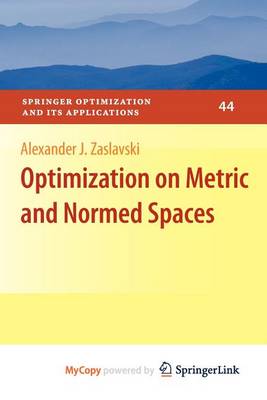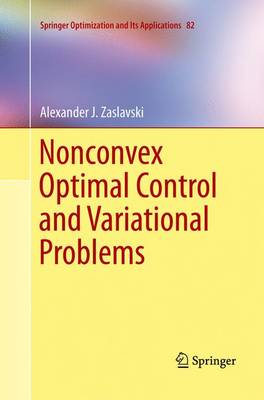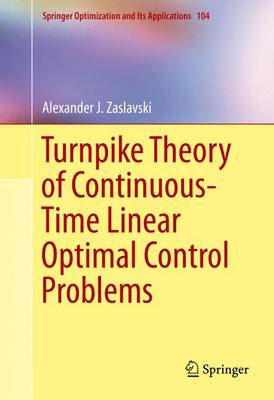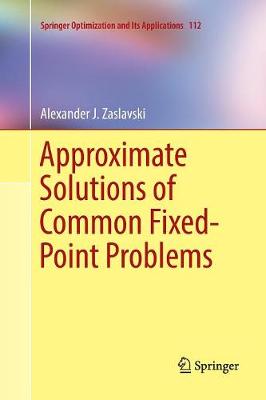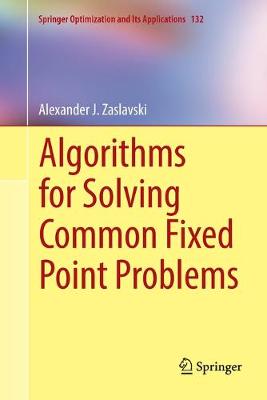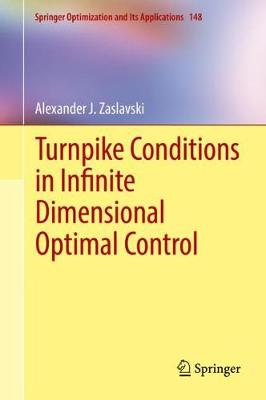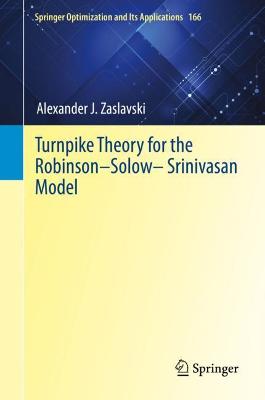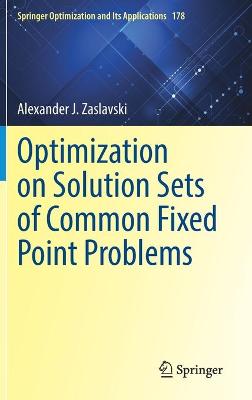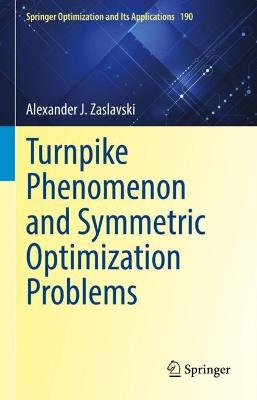Springer Optimization and Its Applications
12 primary works
Book 44
Optimization problems are usually considered on metric spaces satisfying certain compactness assumptions which guarantee the existence of solutions and convergence of algorithms. This book considers spaces that do not satisfy such compactness assumptions. In order to overcome these difficulties, the book uses the Baire category approach and considers approximate solutions. Therefore, it presents a number of new results concerning penalty methods in constrained optimization, existence of solutions in parametric optimization, well-posedness of vector minimization problems, and many other results obtained in the last ten years.
The book is intended for mathematicians interested in optimization and applied functional analysis.
Book 82
Nonconvex Optimal Control and Variational Problems
by Alexander J. Zaslavski
Nonconvex Optimal Control and Variational Problems is an important contribution to the existing literature in the field and is devoted to the presentation of progress made in the last 15 years of research in the area of optimal control and the calculus of variations. This volume contains a number of results concerning well-posedness of optimal control and variational problems, nonoccurrence of the Lavrentiev phenomenon for optimal control and variational problems, and turnpike properties of approximate solutions of variational problems.
Chapter 1 contains an introduction as well as examples of select topics. Chapters 2-5 consider the well-posedness condition using fine tools of general topology and porosity. Chapters 6-8 are devoted to the nonoccurrence of the Lavrentiev phenomenon and contain original results. Chapter 9 focuses on infinite-dimensional linear control problems, and Chapter 10 deals with "good" functions and explores new understandings on the questions of optimality and variational problems. Finally, Chapters 11-12 are centered around the turnpike property, a particular area of expertise for the author.
This volume is intended for mathematicians, engineers, and scientists interested in the calculus of variations, optimal control, optimization, and applied functional analysis, as well as both undergraduate and graduate students specializing in those areas. The text devoted to Turnpike properties may be of particular interest to the economics community.
Book 99
Turnpike Phenomenon and Infinite Horizon Optimal Control
by Alexander J. Zaslavski
This book is devoted to the study of the turnpike phenomenon and describes the existence of solutions for a large variety of infinite horizon optimal control classes of problems. Chapter 1 provides introductory material on turnpike properties. Chapter 2 studies the turnpike phenomenon for discrete-time optimal control problems. The turnpike properties of autonomous problems with extended-value integrands are studied in Chapter 3. Chapter 4 focuses on large classes of infinite horizon optimal control problems without convexity (concavity) assumptions. In Chapter 5, the turnpike results for a class of dynamic discrete-time two-player zero-sum game are proven.
This thorough exposition will be very useful for mathematicians working in the fields of optimal control, the calculus of variations, applied functional analysis and infinite horizon optimization. It may also be used as a primary text in a graduate course in optimal control or as supplementary text for a variety of courses in other disciplines. Researchers in other fields such as economics and game theory, where turnpike properties are well known, will also find this Work valuable.
Book 104
Turnpike Theory of Continuous-Time Linear Optimal Control Problems
by Alexander J. Zaslavski
Individual turnpike results are of great interest due to their numerous applications in engineering and in economic theory; in this book the study is focused on new results of turnpike phenomenon in linear optimal control problems. The book is intended for engineers as well as for mathematicians interested in the calculus of variations, optimal control and in applied functional analysis.
Two large classes of problems are studied in more depth. The first class studied in Chapter 2 consists of linear control problems with periodic nonsmooth convex integrands. Chapters 3-5 consist of linear control problems with autonomous convex smooth integrands. Chapter 6 discusses a turnpike property for dynamic zero-sum games with linear constraints. Chapter 7 examines genericity results. In Chapter 8, the description of structure of variational problems with extended-valued integrands is obtained. Chapter 9 ends the exposition with a study of turnpike phenomenon for dynamic games with extended value integrands.
Book 108
This book studies the approximate solutions of optimization problems in the presence of computational errors. A number of results are presented on the convergence behavior of algorithms in a Hilbert space; these algorithms are examined taking into account computational errors. The author illustrates that algorithms generate a good approximate solution, if computational errors are bounded from above by a small positive constant. Known computational errors are examined with the aim of determining an approximate solution. Researchers and students interested in the optimization theory and its applications will find this book instructive and informative.
This monograph contains 16 chapters; including a chapters devoted to the subgradient projection algorithm, the mirror descent algorithm, gradient projection algorithm, the Weiszfelds method, constrained convex minimization problems, the convergence of a proximal point method in a Hilbert space, the continuous subgradient method, penalty methods and Newton's method.
Book 112
Approximate Solutions of Common Fixed-Point Problems
by Alexander J. Zaslavski
This book presents results on the convergence behavior of algorithms which are known as vital tools for solving convex feasibility problems and common fixed point problems. The main goal for us in dealing with a known computational error is to find what approximate solution can be obtained and how many iterates one needs to find it. According to know results, these algorithms should converge to a solution. In this exposition, these algorithms are studied, taking into account computational errors which remain consistent in practice. In this case the convergence to a solution does not take place. We show that our algorithms generate a good approximate solution if computational errors are bounded from above by a small positive constant.
Beginning with an introduction, this monograph moves on to study:
* dynamic string-averaging methods for common fixed point problems in a Hilbert space
* dynamic string methods for common fixed point problems in a metric space
* dynamic string-averaging version of the proximal algorithm
* common fixed point problems in metric spaces* common fixed point problems in the spaces with distances of the Bregman type
* a proximal algorithm for finding a common zero of a family of maximal monotone operators
* subgradient projections algorithms for convex feasibility problems in Hilbert spaces
Book 132
This book details approximate solutions to common fixed point problems and convex feasibility problems in the presence of perturbations. Convex feasibility problems search for a common point of a finite collection of subsets in a Hilbert space; common fixed point problems pursue a common fixed point of a finite collection of self-mappings in a Hilbert space. A variety of algorithms are considered in this book for solving both types of problems, the study of which has fueled a rapidly growing area of research. This monograph is timely and highlights the numerous applications to engineering, computed tomography, and radiation therapy planning.
Totaling eight chapters, this book begins with an introduction to foundational material and moves on to examine iterative methods in metric spaces. The dynamic string-averaging methods for common fixed point problems in normed space are analyzed in Chapter 3. Dynamic string methods, for common fixed point problems in a metric space are introduced and discussed in Chapter 4. Chapter 5 is devoted to the convergence of an abstract version of the algorithm which has been called component-averaged row projections (CARP). Chapter 6 studies a proximal algorithm for finding a common zero of a family of maximal monotone operators. Chapter 7 extends the results of Chapter 6 for a dynamic string-averaging version of the proximal algorithm. In Chapters 8 subgradient projections algorithms for convex feasibility problems are examined for infinite dimensional Hilbert spaces.
Book 148
Turnpike Conditions in Infinite Dimensional Optimal Control
by Alexander J. Zaslavski
This book provides a comprehensive study of turnpike phenomenon arising in optimal control theory. The focus is on individual (non-generic) turnpike results which are both mathematically significant and have numerous applications in engineering and economic theory. All results obtained in the book are new. New approaches, techniques, and methods are rigorously presented and utilize research from finite-dimensional variational problems and discrete-time optimal control problems to find the necessary conditions for the turnpike phenomenon in infinite dimensional spaces.
The semigroup approach is employed in the discussion as well as PDE descriptions of continuous-time dynamics. The main results on sufficient and necessary conditions for the turnpike property are completely proved and the numerous illustrative examples support the material for the broad spectrum of experts. Mathematicians interested in the calculus of variations, optimal control and in applied functional analysis will find this book a useful guide to the turnpike phenomenon in infinite dimensional spaces. Experts in economic and engineering modeling as well as graduate students will also benefit from the developed techniques and obtained results.
Book 155
The main difference between this new book and the 2016 book is that in this present book the discussion takes into consideration the fact that for every algorithm, its iteration consists of several steps and that computational errors for different steps are generally, different. This fact, which was not taken into account in the previous book, is indeed important in practice. For example, the subgradient projection algorithm consists of two steps. The first step is a calculation of a subgradient of the objective function while in the second one we calculate a projection on the feasible set. In each of these two steps there is a computational error and these two computational errors are different in general.
It may happen that the feasible set is simple and the objective function is complicated. As a result, the computational error, made when one calculates the projection, is essentially smaller than the computational error of the calculation of the subgradient. Clearly, an opposite case is possible too. Another feature of this book is a study of a number of important algorithms which appeared recently in the literature and which are not discussed in the previous book.
This monograph contains 12 chapters. Chapter 1 is an introduction. In Chapter 2 we study the subgradient projection algorithm for minimization of convex and nonsmooth functions. We generalize the results of [NOCE] and establish results which has no prototype in [NOCE]. In Chapter 3 we analyze the mirror descent algorithm for minimization of convex and nonsmooth functions, under the presence of computational errors. For this algorithm each iteration consists of two steps. The first step is a calculation of a subgradient of the objective function while in the second one we solve an auxiliary minimization problem on the set of feasible points. In each of these two steps there is a computational error. We generalize the results of [NOCE] and establish results which has no prototype in [NOCE]. In Chapter 4 we analyze the projected gradient algorithm with a smooth objective function under the presence of computational errors. In Chapter 5 we consider an algorithm, which is an extension of the projection gradient algorithm used for solving linear inverse problems arising in signal/image processing. In Chapter 6 we study continuous subgradient method and continuous subgradient projection algorithm for minimization of convex nonsmooth functions and for computing the saddle points of convex-concave functions, under the presence of computational errors. All the results of this chapter has no prototype in [NOCE]. In Chapters 7-12 we analyze several algorithms under the presence of computational errors which were not considered in [NOCE]. Again, each step of an iteration has a computational errors and we take into account that these errors are, in general, different. An optimization problems with a composite objective function is studied in Chapter 7. A zero-sum game with two-players is considered in Chapter 8. A predicted decrease approximation-based method is used in Chapter 9 for constrained convex optimization. Chapter 10 is devoted to minimization of quasiconvex functions. Minimization of sharp weakly convex functions is discussed in Chapter 11. Chapter 12 is devoted to a generalized projected subgradient method for minimization of a convex function over a set which is not necessarily convex.
The book is of interest for researchers and engineers working in optimization. It also can be useful in preparation courses for graduate students. The main feature of the book which appeals specifically to this audience is the study of the influence of computational errors for several important optimization algorithms. The book is of interest for experts in applications of optimization to engineering and economics.
Book 166
Turnpike Theory for the Robinson-Solow-Srinivasan Model
by Alexander J. Zaslavski
This book is devoted to the study of a class of optimal control problems arising in mathematical economics, related to the Robinson-Solow-Srinivasan (RSS) model. It will be useful for researches interested in the turnpike theory, infinite horizon optimal control and their applications, and mathematical economists. The RSS is a well-known model of economic dynamics that was introduced in the 1960s and as many other models of economic dynamics, the RSS model is determined by an objective function (a utility function) and a set-valued mapping (a technology map). The set-valued map generates a dynamical system whose trajectories are under consideration and the objective function determines an optimality criterion. The goal is to find optimal trajectories of the dynamical system, using the optimality criterion.
Chapter 1 discusses turnpike properties for some classes of discrete time optimal control problems. Chapter 2 present the description of the RSS model and discuss its basic properties. Infinite horizon optimal control problems, related to the RSS model are studied in Chapter 3. Turnpike properties for the RSS model are analyzed in Chapter 4. Chapter 5 studies infinite horizon optimal control problems related to the RSS model with a nonconcave utility function. Chapter 6 focuses on infinite horizon optimal control problems with nonautonomous optimality criterions. Chapter 7 contains turnpike results for a class of discrete-time optimal control problems. Chapter 8 discusses the RSS model and compares different optimality criterions. Chapter 9 is devoted to the study of the turnpike properties for the RSS model. In Chapter 10 the one-dimensional autonomous RSS model is considered and the continuous time RSS model is studied in Chapter 11.Book 178
Optimization on Solution Sets of Common Fixed Point Problems
by Alexander J. Zaslavski
Book 190
Turnpike Phenomenon and Symmetric Optimization Problems
by Alexander J. Zaslavski
This book will be useful for researchers interested in optimal control, calculus of variations turnpike theory and their applications, such as mathematicians, mathematical economists, and researchers in crystallography, to name just a few.
